Achievements, Motivations and Rewards in Faunasphere
by Jason Begy, Mia ConsalvoAbstract
A persistent topic in MMO studies is player motivation: why do players play? Attempts to answer this question have resulted in several frameworks, but these are built from studies of games that are very similar to each other. MMOs tend to feature fictional worlds drawn from common fantasy and science fiction tropes, and gameplay tends to focus on continually improving one’s personal power through leveling up a character and finding new equipment. This in turn has shaped how we interpret player activity. However, casual games developer Big Fish Game’s first MMO, Faunasphere, breaks several of these tropes. Players are cast as “caretakers” of small animals, referred to as “fauna,” and must guide them through the world while improving their home and keeping them happy. The game is almost entirely nonviolent, and the reward for leveling up is not a gain in personal power, but rather an egg used to hatch a new creature to care for. This study examines the players of Faunasphere to determine who they are, what their backgrounds are, and what motivates them to continue playing. We argue that while their motivations seem to fit traditional frameworks, the nature of player activity (as defined by the game’s fiction) is significantly different. This is due in part to the game’s reward structure, which is designed to continually reinforce the player’s position as caretaker: every reward in the game either can be or must be used to further care for one’s fauna. We conclude with a call for greater contextualization when discussing concepts such as reward and achievement: as Faunasphere shows, the fictional world of a game has a strong impact on how players interpret their in-game activities.
Keywords: casual games, MMO studies, gender, fiction, player motivation
Achievements, Motivations and Rewards in Faunasphere
The expansion of markets due to the growing popularity of casual and social games has important implications for how game studies scholars are conceptualizing not just who players are, but how we understand and theorize their activities, specifically their motivations for play. In studying first text-based MUDs and more recently fully three-dimensional MMOGs, online games researchers have largely focused on worlds that employ a fantasy-themed fiction. Such games often feature magic and swords, with races such as elves, dwarves, and humans. Players typically choose a character, race and class, and then begin the long process of advancing or leveling up their character via experience points, going from slaying bats and rabbits to dragons and other large and powerful mythical beasts. Players must usually group together to advance, at least at the most difficult levels, and there is usually some sort of storyline for players to follow, even if it does not impact routine gameplay very much. Responding to those virtual worlds, game scholars have developed models and theories for understanding the complexities of player behavior in such spaces. Bartle (1996) detailed his original four player types--killer, socializer, achiever and explorer--which were then further elaborated upon by scholars. Most notably, Yee (2006) has attempted to detail styles of play that are more complex, arguing that there are three main components of playing--achievement, social, and immersion. Researchers have followed suit, exploring how players in fantasy themed games might fit such components. Yet because the fiction of most MMOGs is relatively similar, this has blinded us to how we are conceptualizing and then interpreting player activity. We have made what now seem to be unquestioned links between styles of play--such as favoring advancement in play--equate to use or exploitation of specific mechanics--such as grinding to level up. What would happen if a different type of MMOG appeared, with different mechanics, or even with similar mechanics, but that have a very different fiction attached? We argue that Faunasphere (Big Fish Games, 2009) is such a game, and that player activity within the game challenges our understandings of what we mean by play styles, such as being achievement oriented, or even being social. This is due to the game’s reward structure, which is designed to continually reinforce the player’s position in the fictional world. In the context of Faunasphere, activities that might be seen as achievement-driven elsewhere take on a different meaning. Using Faunasphere and its player base as an example, this paper argues that just as gameplay is contextual, games researchers must be continually aware of how fiction changes how players interpret mechanics and rewards. Furthermore, researchers must also take into account how play styles that seem similar on the surface can have vastly different underlying motivations, and how fiction influences those motivations.
An Overview of Faunasphere
Faunasphere is the first ‘casual MMOG’ developed by Big Fish Games, a well-known developer and publisher of casual games such as the hidden-object game series Mystery Case Files (Big Fish Games, 2006). Started in 2002 in Seattle, the US-based company has now expanded to more than 400 employees across its central office as well as branches in Vancouver, Canada, and Cork, Ireland. It continues to offer daily releases of single player casual games on its portal, and has also broadened its reach by developing a few multiplayer games for online play, including for social network sites such as Facebook.
As part of that strategy, the company launched the free-to-play Faunasphere, in 2009 as a stand alone web-based game, after heavy promotion via its casual games portal sites. Faunasphere blends elements of both casual and MMOG gameplay into its design, and in February 2010 the company debuted the game (with additional social mechanics) on Facebook.
Players of Faunasphere are called Caretakers, and their job is to raise diverse types of “fauna.” Players begin the game with one fauna, which the player must use to zap pollution (rather than kill monsters), which appears as cube-like entities in the game (Figures 1 and 2). Each zapped cube yields money, experience points and items. Once a certain level of XP is reached the fauna gains a level, and also lays an egg. Players can level a fauna to a maximum of 20 through the zapping of pollution as well as the completion of various goals (quests in MMOG-speak) in the gameworld.
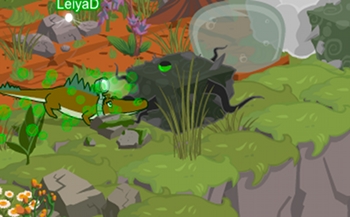
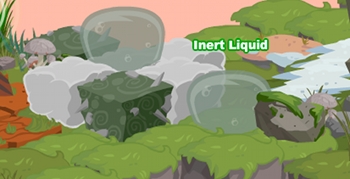
Figures 1 (Top) and 2 (Bottom): Zapping various kinds of pollution
Beyond leveling fauna, players can also engage in several other activities, such as decorating one’s personal faunasphere, breeding fauna, or participating in raffles and other community events.
Upon logging in to the game the player begins in his or her own faunasphere, a customizable space that serves as the fauna’s “home.” The faunasphere includes a den, where fauna can rest to recover their energy and “happiness” (effectively their health points), and a nest, which is needed for breeding. Caretakers can decorate their faunasphere areas, using items found through gameplay, items won in various contests, or items placed for sale by developers as well as other players. There are periodic contests to reward the best-designed spheres, and players can visit one another’s spheres, which encourages players to create visually interesting and/or pleasing environments (Figures 3 and 4).
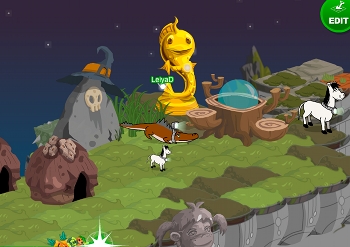
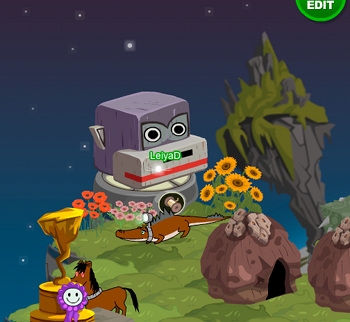
Figures 3 (Top) and 4 (Bottom): Images of a player’s faunasphere with various decorations
As mentioned above, upon leveling-up a fauna lays an egg, which can be used to give birth to a new fauna, traded, sold or gifted to other players. To hatch, eggs must be incubated in a nest by a fauna, and if the fauna that incubates the egg is different from the fauna who laid the egg a unique fauna will result, usually with some combination of features from its parent fauna, but sometimes with new or unique features (occasionally even a new species of fauna) resulting.
Players begin the game with one of three basic fauna types, and are urged by the game (as well as other players) to quickly begin experimenting with breeding to see what interesting combinations they can create. Over time players may hatch more advanced fauna as their collection grows (Figures 5 and 6).

Figure 5: A more advanced fauna type (Chomper).
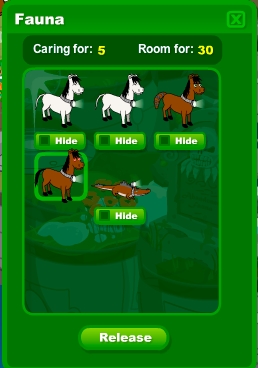
Figure 6: Available fauna, including a basic fauna type (Hoofer). Note that the image indicates how many fauna are currently being “cared for,” which equates to the number of fauna the player has at his or her disposal.
Faunasphere fits the standard definition of an MMO in that the game takes place in a persistent world to which all players are connected simultaneously, and it includes (graphical) avatars that players can control. As such, during a play session other caretakers will be encountered, and it is possible to chat and trade items with them. Players have “friend lists” to which they can add other users. The friend list shows which friends are online, and also allows a player to “jump” to a friend’s current location instantly. Despite this, Faunasphere is designed to be playable in a solo manner. The game also incorporates traditional MMOG elements such as offering players goals and activities to pursue, as well as regions to explore and items to collect. Some activities such as zapping pollution occasionally require help to achieve rewards more easily, and the patronage system does ask players to visit one another’s spheres in order to buy various items. But there is no penalty for going about most activities on one’s own, interacting as little as possible with other players. The game requires no real interaction between its many players. So even as one can play alongside others, the game is different from most other MMOGs in that it omits grouping mechanics, and does not support social structures such as guilds.
Yet in addition to being an MMOG, Faunasphere also adheres to key casual game design principles, as indicated by our prior description. Kultima (2009) argues that casual games, in contrast to typical “hardcore” games, usually offer players more acceptable game content (less violence, fewer dark themes), greater accessibility (easier to play), simplicity (stripped down number of rules or actions) and flexibility (greater error forgiveness, allows for player to start and stop playing easily) (2009). Similarly, Juul stresses that casual games tend to have a positive fiction, presuppose little or no prior knowledge of videogame conventions, allow the player to play in brief bursts, are lenient in their punishments and excessive in positive reinforcement (2009).
Faunasphere certainly features a positive setting: as noted above, players are cast in the role of Caretakers for a group of small, cute animals. Violence is almost non-existent in the game. Zapping pollution might be construed as violent, as some pollution can harm fauna by decreasing the fauna’s current level of happiness, but the act itself (cleaning up the environment) is still positive. The game is conducive to both long and short play sessions: there is always something else for players to do, and the game saves progress automatically, allowing players to easily quit and resume what they were doing later on. Punishment in the game is appropriately lenient: even if a fauna’s happiness becomes depleted, it is sent back to the player’s faunasphere to rest. The only real cost of failure is a small amount of time. The game is perhaps less “casual” in terms of accessibility: players acquire a great number of items very quickly, but are given little information on what these items are for. However, as we will show later, this has not deterred a great number of casual games players from enjoying Faunasphere.
Research Questions and Previous Work
Faunasphere’s blending of MMOG-style gameplay and elements of casual games design challenges our current understanding of who plays MMOGs and what pleasures they take from doing so. In particular, Faunasphere’s fictional world (Juul, 2007) is so different from those of more traditional MMOGs that it raises questions about the nature of achievement, motivation, and reward. As such, we approached our study with the following research questions in mind:
- RQ1: How do players of Faunasphere compare with what we know about players of casual games?
- RQ2: What role does Faunasphere’s fiction play in shaping player motivation?
- RQ3: How is achievement expressed in Faunasphere?
Because Faunasphere blends design elements from MMOGs, casual games and social games, and (as we found in our survey) is predominantly played by women over 35, answering these questions requires bringing together several areas of game studies research. Specifically, we see the helpfulness of combining theorization done in three areas: gender and games, the emerging focus on casual games and casual players, and the relatively more established work done in MMOG studies. According to the work of Consalvo (2009) and Juul (2009) there are increasing convergences in these areas concerning players’ play styles (as well as game design) that must be explored. Such work gives us a better understanding of individuals’ relationships with games and play, and advances theorizing in game studies. Likewise, Jensen and de Castell argue, much work on women and games has taken the ‘lack’ of women playing games as a central focus, or has investigated the stated gaming preferences of women and girls, without understanding the contexts behind those choices. They instead assert that “while girls and women do play, what and how they play is always negotiable, context dependent, and usually not necessarily in the company of other girls or female players" (2010, p. 56). We take those cautions into account in this study, which features a prevalence of female game players engaging in activities that contradict as well as sometimes support traditional assumptions about female gamers.
MMOG Studies: Player Motivation and GenderA central focus for researchers studying the activities of MMOG players is examining motivations for play, specifically exploring the different reasons for playing and the varying pleasures that players engage in while playing games like World of Warcraft (Blizzard, 2004) and Lord of the Rings Online (Turbine, 2007). While Bartle (1996) provided one of the earliest taxonomies of player styles, Yee (2006) has further fleshed out those models, to account for the more complex interests players might bring to their play styles as well as the evolving nature of virtual worlds. Importantly, he suggests that different motivations may not mutually exclude one another, and that “MMORPGs may appeal to many players because they are able to cater to many different kinds of play styles” (p. 772). Yee details three main components of playing: achievement (advancement, mechanics, competition); social (socializing, relationship, teamwork); and immersion (discovery, role-playing, customization, escapism), with various players differing on the weights they attach to those various components.
Some scholars have found particular gender patterns in relation to those different styles, with female players scoring higher on social motivators, and male players emphasizing achievement (Williams et al 2009, Yee 2006). However, Yee has argued that “variation in the achievement subcomponent is in fact better explained by age than gender” (p. 774) and that “male players socialize just as much as female players, but are looking for very different things in those relationships” (p. 774).
In contrast, a recent study of Everquest 2 (Sony, 2004) players found that “women are more likely to play for social interaction and the men to achieve (Williams et al, 2009, p. 717), even as “it was the female players who were the most intense and dedicated ‘hardcore’ players, playing more often (if in smaller overall numbers) and with more dedication than the males (as indicated by lower likelihood of quitting)” (p. 716). Yet the authors also suggest that even if women do start playing MMOGs for social reasons, they may also develop interests in competitive or cooperative activities (p. 721). Such theorization aligns with earlier work done by Taylor (2006), who studied players of the first Everquest game (Verant Interactive, 1999), finding that many female players enjoyed the challenges presented by the game, and took pleasure in advancing their characters, gaining power, and defeating both human and non-human enemies in the world. Thus the evidence from MMOG studies suggests that players can have multiple motivations for play, and there is mixed evidence regarding how male and female players align in regard to those patterns.
Casual GamesIn contrast to the relatively lower number of female players in MMOGs, casual games have almost consistently featured a strong female demographic for a player base, with that group also older than the typical male console gamer. In one of the few surveys of players of casual games, Juul drew from the readership base at Gamezebo.com (a portal for news, reviews, and community interactions focused on casual games), finding that 93% of respondents were female, and the average age was 41. Those players were also quite dedicated: 35% reported playing several times a day for at least one hour at a time, and 14% played several times a day for more than three hours (2009). Confirming that level of play intensity, Consalvo studied fans of the single-player casual game Mystery Case Files: Return to Ravenhearst (Big Fish Games, 2008), finding that “many players of casual games are not at all casual in how they play or think about such games. At least some players are heavily invested in anticipating new titles, discussing various aspects of past and future games, and solving the mysteries that some games provide” (2009, p. 53).
Thus adult female game players can be very dedicated to their play, whether it encompasses a more “hardcore” MMOG or more user-friendly single-player games like those in the Diner Dash (Game Lab, 2003) series. This suggests that players of casual as well as more mainstream games may be anything but casual in how they approach play. Thus we need to be extremely cautious in thinking through their motivations for play, as well as what types of games might “logically” appeal to female players.
Another key point to highlight from recent work on casual games concerns unpacking the term ‘casual’ itself, for as Kuittinnen et al argue, it can refer to “types of games, types of game player, play styles, [and] distribution and production (genre) models” (2007, p. 110). All researchers who have studied players of casual games, further, have concluded along with Juul that “what we do know is that the most dedicated players of downloadable casual games are, indeed, extremely dedicated” (p. 156). We must keep in mind that the players of a more seemingly hardcore MMOG and those playing single-player downloadable games may not be so different in their time spent playing, investment in play, or even play styles.
Methods
This study used a mixed methods approach to answer its research questions. We began by playing Faunasphere extensively yet informally, to familiarize ourselves with the context of the space, as well as to gain familiarity with the lingo and conventions of the game. We also began to read the official Faunasphere forums on the Big Fish Games site to gain a better understanding of what (at least some) players valued, how they interacted with one another as well as with the forum staff, and what issues seemed to be of most concern to players. Our presence as researchers during this phase was unknown to the player community, however, we refrained from posting to the forums and engaging with other players.
During this period we also requested and received aggregate gameplay usage data from Big Fish Games, and interviewed one of Faunasphere’s community managers to get a better sense of the community surrounding Faunasphere. By examining this quantitative and qualitative data, we moved to a more systematic method to broadly capture a snapshot of Faunasphere players and their gameplay practices.
We next developed a pilot survey, inclusive of both closed and open-ended questions, asking players about their gameplay experiences in the game, their past gaming experience, their feelings about other players, their use of the forums, as well as basic demographics and current play patterns. We pilot tested the survey and based on those results we refined its language and rephrased unclear questions. The survey was designed to be anonymous, although we do have basic location information from respondents including country, state and city of origin. We also limited participants to those 18 or older, although Big Fish Games does allow younger players to play the game, with parental consent. When the survey was ready we contacted Big Fish Games, and they volunteered to have the community manager post an explanation and link to the survey to the game forums, and to include a link to the survey in their regular newsletter to players of Faunasphere. We kept the survey active for approximately three weeks in March 2010, during which time we received 671 completed surveys.
For this analysis we have mostly examined frequencies of responses and correlations of various identity and use patterns. We compare this data with usage statistics provided by Big Fish Games as well as with usage statistics other researchers have found from players of casual and MMOG-style games. We also draw from open-ended responses as appropriate. To analyze those elements we relied on textual analysis and identified predominant themes arising from players themselves. We cross-checked our analyses and emergent patterns with one another, to ascertain whether our findings were reliable and best represented the words of participants.
Who Plays Faunasphere, How Much, & Why
Before exploring motivations for play, it’s useful to give some details regarding what types of individuals currently play Faunasphere, and some basic information regarding their play frequency and duration. Overall, our survey results show that the players of Faunasphere mirror the demographics of typical players of casual games, both in terms of gender and age as well as prior game experience, rather than MMOG players, but do also share the heavy play styles of dedicated MMOG and casual game players.
DemographicsDemographically the survey respondents aligned with Juul’s survey of Gamezebo.com readers (2009). Of the 671 respondents, 93% were female (Figure 7), while 71% were over the age of 35 (Figure 8).
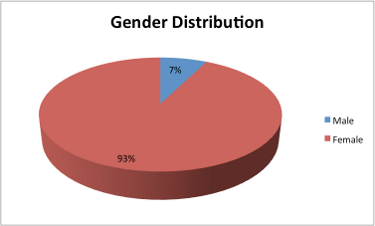
Figure 7: 93% of survey respondents were female
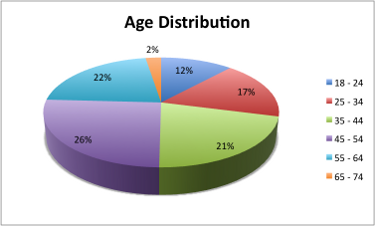
Figure 8: 71% of respondents were over the age of 35
In terms of prior game experience, the majority of respondents were new to MMOGs. Sixty-one percent of respondents had never played another MMOG, while another 5% did not know what the term MMOG meant; only 10% of respondents reported currently playing another MMOG. However, younger players were slightly more likely to play than older players. While 18% of 18-24 year olds reported currently playing another MMOG, fewer than 10% of 45-64 year olds did the same.
The data also shows that many players were already familiar with casual games before they encountered Faunasphere. Overall, 81% of all respondents reported being a Big Fish Games customer prior to playing Faunasphere, while another 4% became Big Fish Games customers due to their Faunasphere experience (Figure 9).
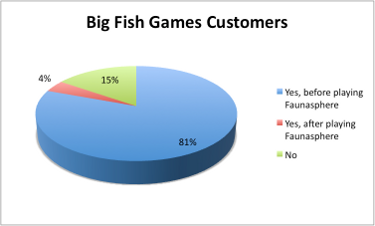
Figure 9: A majority of respondents were already customers of Big Fish Games.
Additionally, 78% of respondents learned about Faunasphere from Big Fish Games directly, be it via advertising on the BFG website, acting as a beta tester, reading about the game in the BFG newsletter and forums, or through promotional email. From this data it is clear that the survey respondents were already active in and familiar with casual games prior to encountering Faunasphere, rather than coming from a background featuring more traditional MMOGs.
Player DedicationThe data shows that Faunasphere players are extremely invested in the game. This is in line with both studies of casual game players such as Juul’s survey of Gamezebo.com readers (2009) and Consalvo’s study of Ravenhearst fans (2009), as well as studies of MMOG players by Yee (2006), Taylor (2006) and Williams et al (2009). Play sessions among respondents were typically quite long, with 51% reporting an average session length of greater than two hours. Another 27% reported playing between one and two hours per session; a further 11% play between 41 and 60 minutes at a time, on average. The respondents also play frequently, with 41% of respondents reported playing several times each day, while another 37% played daily.
Those who played the longest sessions also tended to play the most frequently. Almost 65% of those who reported playing several times a day also claimed their average play sessions were over 2 hours in length, suggesting the most avid players are in Faunasphere for more than 20 hours per week, at minimum, similar to many MMOG players. Additionally, 52% of daily players reported average play sessions of over two hours in length. Older players also tended to play more frequently than younger players. While only 19% of 18-24 year olds play either several times a day or daily, 53% of 45-54 year olds and 48% of 55-64 year olds reported similar play frequencies.
However, according to data provided to us by Big Fish Games, the average session time for all players is only 45 minutes, indicating two possible alternatives: first, that the survey attracted a disproportionately high number of extremely dedicated players (which was to be expected given the distribution channels), or second, that self-reporting players over-estimated the amount of time they spent actually playing the game. We are inclined to lend more weight to the first explanation, particularly as other research has found that many players tend to under-estimate their time spent playing, with women being even more likely to do so than men (Williams et al, 2009). Yet the findings do raising an important caution to all games researchers--that relying on non-random samples is likely to result in findings that are skewed towards the interests and activities of the most dedicated players.
Fauna and MembershipFurther evidence for the dedication of the survey respondents can be seen in the data regarding fauna ownership and membership levels. In Faunasphere players own multiple fauna at the same time, with the exact number depending on the status of their membership--free members are limited to three fauna, while platinum members can have up to thirty. While only one fauna can be used at a time (analogous to multiple characters in a typical MMOG), it is simple to switch to another whenever the player so desires. All fauna begin at level one, and at the time of this writing can reach a maximum level of twenty. When asked about their highest-level fauna, 18% of respondents reported that they had at least one fauna at level twenty, and that they still used that fauna. Another 33% had their highest-level fauna at level sixteen or above, and for another 29% of respondents their highest-level fauna was between eleven and fifteen. Altogether, 80%[1] had their highest-level fauna at level eleven or higher. Again this stands in contrast to data from Big Fish Games, which reports that (excluding level 0 fauna), the average level of all fauna is 2.6. This data further supports our conclusion that the survey attracted the most dedicated players.
In line with a growing number of social games and MMOGs[2] that feature free accounts with optional premium elements to purchase, players of Faunasphere have different types of accounts corresponding with their membership level. This level determines how many fauna the player may have at once, and also determines a monthly payout of “Bux.” Bux is a premium currency (in addition to the standard “Lux”) needed to purchase certain items. Membership details for Faunasphere are summarized below in Table 1.[3]
| Membership Type | % of respondents | # of respondents | Max Fauna | Cost/Mo. (USD) | Bux / Mo. |
|---|---|---|---|---|---|
| Platinum | 57.10% | 382 | 30 | $9.99 | 4000 |
| Gold | 14.05% | 94 | 15 | $4.99 | 1500 |
| Silver | 5.83% | 39 | 6 | $2.49 | 600 |
| Free | 23.02% | 154 | 3 | $0.00 | 0 |
Table 1: Membership level distribution.
From this data we can see that 77% of survey respondents were paying for an optional monthly Faunasphere subscription. Furthermore, 63% of players have made one-time purchases of Bux. Of that subset, 52% reported having done so four or more times, and slightly more than half (57%) reported an average purchase amount of 2,400 Bux or more. It should be noted, however, that Bux are pro-rated such that when larger quantities are purchased the cost-per-Bux decreases; purchasing Bux in amounts of 2,400 or more is the most cost-effective option. Additionally, higher membership levels pay less for Bux. As such, a platinum member can purchase 2400 Bux for $4.99, while a non-paying member would pay $9.99 for the same amount.[4] This incentivizes players to opt for higher-level, higher-cost memberships.
It is interesting to note that 64% of women players purchased Bux, while only 48% of male players did so. Nick Yee's earlier surveys of MMOG players found that 22% of all respondents reported purchasing virtual currency (however such purchases are most often illegal in MMOGs) and "male and female players were equally likely to purchase virtual currency," although there was a mild correlation with age (older players being slightly more likely to buy currency than younger players) (Yee, 2005). Our findings are more in line with the practices of those playing social games, where, as Steve Meretzky has reported, women are more likely to buy virtual currency than men (2010). It may also be the case that comfort with or loyalty to Big Fish Games played a part in players’ willingness to purchase currency or buy a paid membership. While 83% of women were Big Fish Games members before playing Faunasphere, only 56% of men were members before trying the game. Membership with Big Fish Games entails paying a monthly fee, and so prior customers may already have been familiar with that system, and trusted the company (for either the quality of its games or its customer service) enough to pay for their experiences in Faunasphere. Thus it remains an open question as to what factor was more important for purchasing paid memberships and virtual currency-whether it was gender or prior experience with Big Fish Games. However, we did find that older players were more likely to buy Bux than younger players, with the following distribution for female players (see Table 2). Men's Bux buying frequency did not change appreciably with their age (although the N was so small, it is difficult to generalize here).
| Age | % that bought Bux |
|---|---|
| 18-24 | 38% |
| 25-34 | 54% |
| 35-44 | 63% |
| 45-54 | 70% |
| 55-64 | 78% |
| 65-74 | 69% |
Table 2: Female players that bought Bux outside of membership
Lastly, the likelihood of being a paying member also rises with age. While 54% of 18-24 year olds were Free members, only 26% were Platinum members. In contrast, only 17% of 45-54 year olds identified themselves as Free members, while 68% were Platinum members. Getting older still, only 12% of 55-64 year olds were Free members, but 71% reported being Platinum members.[5]
The significance of this data and its relation to player dedication derives from the design of the game: paid memberships allows members to own more fauna and purchase premium items, although neither of those activities is essential to progress in or necessarily enjoy the game. But the privileges that come with membership (more fauna, Bux) do make the game more rewarding to play for individuals interested in particular gameplay mechanics and elements. Most critically, the game revolves around breeding fauna and decorating one’s faunasphere in unique and/or aesthetically pleasing ways. Doing both is made easier through access to a premium account. Such accounts allow players to embark on more ambitious breeding projects, since more fauna can be stored, and thus can be held in reserve for experimentation to breed for particular fauna characteristics or even types of fauna. Conducting extensive breeding projects while being limited to three fauna is simply not possible.
Similarly, some items can only be purchased with Bux, with these being luxury, non-essential items. Such items are largely non-functional, yet serve as decorative items in players’ spheres, which are visited by other players and sometimes entered into design contests. Thus to be as creative as possible and obtain what are potentially exclusive items, players must again be willing to either pay for Bux via regular purchases, or sign up for a paid account, which gives access to regular Bux payouts as well as discounts for additional Bux purchases. Thus we can see that survey respondents, although playing what the industry terms a casual game (or MMOG), are definitely not casual players.
LoyaltyFinally, respondents were quite loyal to Faunasphere. Overall, 65% of players indicated that they would either keep playing the game indefinitely, or “play even more” in the future. Only approximately 6% reported they had either already stopped playing, or had plans to quit “soon.” Such findings are also in line with Yee, who has also found that female players are more often invested in games than their male partners, reporting less likelihood of leaving (2004). Our frequencies were too low in regards to male players to make reliable assertions in that regard, but interesting differences do arise between paying and free members. Free members are by definition less invested in the game.
When exploring the future plans of free members in relation to platinum members, we found the following. First, Platinum members are more likely to state they will either be playing more or at about the same level in the future (68%) than are free members (56%). Free members are slightly more likely to report planning to play less in the future, either because they are busy or losing interest (27% of free players versus 21% of Platinum players). Finally, 10% of free members reported that they either were not currently playing anymore or had plans to quit, while only 5% of Platinum members reported such feelings.
Motivations for PlayIn order to study what players enjoyed the most in Faunasphere, we asked them to rank order a list of activities comprising game’s central components. Contrary to the results of Williams et al’s study of EverQuest 2 players (2009), our results show that the predominantly female players of Faunasphere are largely motivated by activities that signify achievement, as opposed to the expected social elements other researchers have attributed to female players (Yee 2006). Respondents were asked to rank a set of in-game activities on a scale from 1 to 7, where a 1 corresponds to “most favorite” and a 7 “least favorite.” Results are shown below in Table 3.
| Activity | Average Ranking |
|---|---|
| Completing Goals | 2.7 |
| Leveling Up Fauna | 3.0 |
| Breeding Fauna | 3.4 |
| Building/Decorating my Faunasphere | 3.8 |
| Interacting with Friends | 4.2 |
| Raffles and Patronage | 5.4 |
| Special Events | 5.5 |
Table 3: Average rank of in-game activities. Respondents ordered the set of activities from 1 to 7, with 1 being their favorite and 7 their least favorite.
The three most popular activities were Completing Goals, Leveling Up, and Breeding. Each of these fall under the achievement component in that they relate to progressing within the game (Yee 2006), though--as we discuss under “Reward Structure”--these are all somewhat related.[6]
In contrast, activities that could be considered social (Yee 2006) were ranked quite low. Only 10% of respondents rated “interacting with friends” as their most favorite activity, with the activity’s average rating only 4.2. Additionally, only 24% of respondents reported having more than one hundred friends on their friend list, despite a maximum of three hundred. Friend lists are also somewhat utilitarian in Faunasphere, as they allow players to visit the spheres of friends, where they can either buy needed items or simply view another players’ sphere decorations. While they also let players know if that friend is available, the relatively low number of friends coupled with the functional aspects suggests that this function is not widely used for sociality.
This is not to suggest that there is no social activity in Faunasphere, but rather that it is not the central aspect of the game for many players, and indeed the game offers few incentives or requirements for socializing or interacting with other players in a structural manner. When asked how often they actually chatted with friends over in-game open chat, 42% reported doing so always or frequently, while 58% reported doing so occasionally, rarely, or never. When asked the same question about how often they chatted with friends in-game via private message, 40% reported doing so frequently or always, while 60% reported doing so occasionally, rarely, or never. The majority of respondents (66%) do not know any of their in-game friends outside of the game.[7] Participation in the official Faunasphere forums was also low, with 61% reporting that they post to the forums rarely or never. This statistic is surprisingly low given that, as we have already seen, the survey seems to have been taken by the more dedicated players. The question as to whether less-dedicated players have similar motivations for play is, for now, an open one.
From this data it is clear that the most dedicated Faunasphere players are women who come from a casual games background, have little MMOG experience, and are predominantly motivated by the achievement component. This aligns with Taylor’s research into female players of Everquest, who enjoyed elements of the game such as leveling-up and defeating enemies, which would fall under the achievement component (2006). Additionally, Williams et al’s study of Everquest 2 players found that female players were more motivated by the social component than the males, but note that even if these women began playing for social reasons, these reasons are not necessarily why they continue to play (2009).
Players, Fiction, and Rewards
One of our research questions asks what role the fiction of Faunasphere plays in shaping player motivation. While the data from our survey supports some earlier findings about the importance of achievement in play, the fictional world of Faunasphere offers some complications to how we conceptualize our ideas of achievement and what ‘counts’ as such activity. To review, survey respondents overwhelmingly preferred in-game tasks and activities that generally fall under the achievement component. The only social component that was included as an option was “interacting with friends,” which out of seven choices was ranked fifth, suggesting it was not very popular among respondents. However, unlike in most MMOGs, players of Faunasphere have no “avatar” in the traditional sense. Rather, players are addressed directly by the game as “caretakers.” Each player has a number of fauna to select from, which is functionally similar to the different characters a player of a traditional MMOG might have. But these fauna are seen as being cared for by the players; the player’s identity is not projected into the world beyond the mouse pointer being used for interaction. This attitude is reflected in the forums, where players continually express sadness over having to release a fauna when at their limit,[8] or when players post announcing that one of their fauna (not the player themselves) has reached level twenty[9]. Fauna are seen as being distinct entities from the players themselves.
This notion of “caretaking” is extended into the game’s reward structure. Faunasphere features a cascading reward system with two defining attributes: a mix of pre-determined and user-selected rewards, and an overall focus on enabling players to fulfill their fictional roles as caretakers.
The primary reward in Faunasphere is Lux, which is the basic currency. Lux is earned by zapping pollution or completing goals, and is used to purchase goods from shops or other players’ totems. Whenever Lux is earned, an equivalent amount of experience points (XP) are earned at the same time (experience points are not lost when Lux is spent). When a fauna earns a predetermined amount of experience points it gains a level--much as in other MMOs--and lays an egg. Eggs are used to hatch new fauna, and can be bought, sold, gifted and traded just like other items in the game. At the highest level, Faunasphere’s reward structure can be thought of as a series of deterministic relationships. Earning Lux always entails earning XP, which always entails earning new eggs. This process is illustrated below in Figure 10.
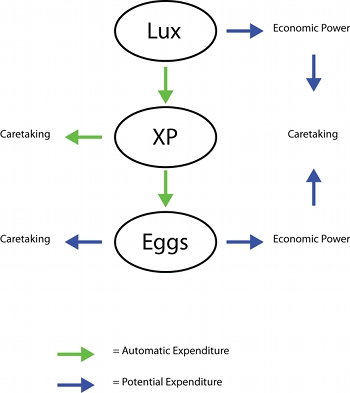
Figure 10: Faunasphere’s Reward Structure
In Figure 10 the three main reward elements are indicated by the three ovals. Green arrows between elements indicate a deterministic relationship: Lux always becomes XP, which always leads to eggs; players cannot interrupt or stop this progression. Also in this diagram are two secondary elements: caretaking and economic power. “Caretaking” refers to items, events and actions associated with the player’s fictional role as caretaker, whereas “economic power” refers to Lux or the ability to acquire Lux.[10] Note that in the diagram there is a direct relationship between earning XP and caretaking. This is because of the player’s roles as caretakers, and from various forum postings (see notes 8 and 9) it is clear that many players see themselves as such. Leveling up a fauna is not about gaining in power or prestige as it is in most MMOGs, but rather about caring for that fauna. The connection between eggs and caretaking is considered a potential expenditure because the player does have some choice. Eggs can be hatched, thus increasing the player’s number of fauna, and they can also be exchanged like any other item. Thus they can be considered to represent economic power as well, as indicated in the diagram. Finally, economic power can always be expended on caretaking. Many of the items available in the game relate to fauna, either directly (in the case of food items and eggs) or indirectly (items used to build dens, faunasphere components). As such, what seems to be a varied, multilevel reward structure is actually tightly designed to direct a player’s attention back onto his or her fauna. Furthermore, the cascading nature means that whenever a player is rewarded they are also working towards a long-term reward: earning Lux now means earning eggs later; players are always progressing towards better rewards. That this structure is effective can be seen in the data on player motivation, which shows that a vast majority of players favor activities that either result in one of the three main rewards (completing goals, leveling up fauna) or depends on them (breeding fauna).
The significance of this structure and its ties to Faunasphere’s fiction is that it complicates previous notions about the nature of achievement. As described above, the survey data shows that the three most popular in-game activities are completing goals, leveling-up fauna, and breeding fauna. On the surface these all seem to fall under Yee’s achievement component (2006), but as shown in Figure 10 the rewards for all of these activities can be seen as nurturing, as all are beneficial to the player and his or her fauna. Furthermore, we know that the fictional world of Faunasphere is significant to the players. This is indicated by the previously-noted forum postings. Additionally, Juul (2009) and Kultima (2009) both identify positive fiction as a key trait of casual game design. Given that the majority of respondents are also players of casual games, we can conclude that the game’s fiction is at least in some degree a significant factor in their choice of games. Faunasphere shows that an analysis of what constitutes “achievement” or progressing within a game must be contextualized within the game’s fiction, as similar activities can take on very different meanings for players.
Conclusions
As the market for video games continues to expand, it is probable that more hybrid spaces such as Faunasphere will appear. In order to study and understand these new types of games, and their players, it will be necessary to rethink many of our assumptions. By examining how Faunasphere blends elements of casual games and MMOGs, this study has attempted to do just that.
To reiterate, we approached this study with the following research questions in mind:
- RQ1: How do players of Faunasphere compare with what we know about players of casual games?
- RQ2: What role does Faunasphere’s fiction play in shaping player motivation?
- RQ3: How is achievement expressed in Faunasphere?
In terms of question one, the data aligns with Juul’s study (2009): both surveys found that players of casual games are predominately women over the age of thirty-five. This was not surprising, given that the majority of survey respondents were playing casual games before coming to Faunasphere, and indeed most were already active patrons of Big Fish Games. This indicates that there is room for expansion in the casual market: here players of typical casual games have migrated to an MMOG, which suggests movement towards other genres may be possible. Additionally, our findings align with prior studies (Consalvo 2009, Juul 2009) in showing that players of casual games exhibit a high degree of dedication to their game playing. However, when considering social game players, differences in the findings become important to note. The company’s decision to bring the game to Facebook (and presumably reach a wider audience, both in sheer scale as well as demographically) was not a success. At its most popular, Faunasphere on Facebook claimed over 340,000 Monthly Active Users, but by January 2011 that figure was down to slightly more than 25,000 MAU. Thus although the game features many elements of similar social games (persistence, positive themes, short gameplay sessions) it did not fare well against competitors such as Frontierville (Zynga, 2010).
For questions two and three we found the answers to be intertwined. Faunasphere’s reward system is closely linked to the game’s fiction: all of the rewards further enable the players to enact their roles as caretakers. As such, achievement is also connected to caretaking: major accomplishments, such as breeding a new fauna or reaching level twenty, can be related back to caretaking. Thus achievement in Faunasphere is different from achievement in a traditional MMOG, where major accomplishments are typically connected to gaining power within the game world. Although Faunasphere is just one example, it shows that “achievement” on its own is too broad a term, and needs to be contextualized within a given game. The fictional world of a game directly impacts the nature of achievement in that game.
Likewise, the design of the game privileges achievement mechanics over social mechanics. Faunasphere does not require players to group together to achieve goals, zap pollution, or explore. Instead, those activities remain possible when playing alone. Although players must interact with others if they wish to trade or buy and sell eggs as well as faunasphere decorations, those activities can easily be accomplished via the game’s marketplace feature, and do not require synchronous, coordinated interaction. Multiplying upon this, (or subtracting), there is also no reason for players to form more permanent social groupings such as guilds, as they serve little purpose beyond what can be accomplished via a friends list. Thus, underlying structures of the game that likewise support its fiction are also likely work to diminish interest in complex forms of socialization among players. Such decisions reveal how design components of a game shape resulting player activities and interests, and should again cause us to question what different player groups--such as the female players of Faunasphere--‘naturally’ like or find important in motivating them to play.
In conclusion, our call for contextualization with regards to achievement, rewards and fiction is similar to Jensen and de Castell’s insistence on contextualizing the preferences of women gamers. While Faunasphere is predominately played by women, it would be fallacious to assume that we can draw conclusions about women gamers as a homogenous group based on the game’s design. This study does not argue that women like Faunasphere because of the emphasis on caretaking, for instance. Rather, what this study has shown is that new, hybrid spaces like Faunasphere are likely to continue emerging, and that as researchers we must continue to adapt our theoretical toolsets as necessary, paying attention to the complex interplay of design structures, game fictions, and player actions as they work in tandem with one another.
Notes:
[1]Thirteen respondents answered N/A
[2]Almost all social games follow this model, with the best known examples including Farmville, Mafia Wars, Frontierville and Social City. Free-to-play MMOGs include Maple Story, Puzzle Pirates and Habbo Hotel, although even MMOGs that once charged monthly membership fees are now experimenting with this model, including The Lord of the Rings Online and Dungeons and Dragons Online.
[3]Two respondents answered N/A
[4]For detailed pricing information see here
[5]We did not have membership breakdowns from Big Fish Games to make a comparison with our survey respondents.
[6]Favorite activities differ slightly between Platinum members and Free members. Completing Goals was the top activity for both Platinum and Free members, with 35% of Platinum members rating it as a "top three" activity and 39% of Free members doing the same. However, while 32% of Platinum members rated Breeding Fauna as in their top three, only 22% of Free members did so. That may be because Free members are limited to caring for only three fauna at a time"thus breeding multiple fauna is a challenge. Finally, 33% of Platinum members rated Leveling Up in their top three, and 39% of Free members did so as well. Despite small differences in the ranking of these three activities between free and paying members, however, they were still more popular overall with all members than the other alternatives, which included decorating one’s faunasphere, participating in raffles and patronage, and socializing with friends.
[7]While this is an area we did not formally study, it became clear that players learned to play this game via either trial-and-error or through consultation of other members, or more likely a combination of both. Early beta testers of the game were largely drawn from membership at the Big Fish Games site, suggesting that the players mentoring one another were mostly women. This finding is similar to Taylor & Witkowski (2010)’s observation at a Swedish LAN party that female players were starting to mentor one another, rather than relying on male mentors, as past generations of female players have done. Similarly, Kolos (2010) found the beginnings of female mentoring of gameplay in a college setting. We believe such activities are important and in need of further attention, although at this point we can not make any conclusions about how this might have affected players’ play styles, activities, or interests.
[8]Forum threads about releasing fauna: http://forums.faunasphere.com/posts/list/8318.page http://forums.faunasphere.com/posts/list/6698.page http://forums.faunasphere.com/posts/list/9477.page http://forums.faunasphere.com/posts/list/5191.page http://forums.faunasphere.com/posts/list/3954.page
[9]Forum threads about reaching level 20: http://forums.faunasphere.com/posts/list/4514.page http://forums.faunasphere.com/posts/list/8161.page http://forums.faunasphere.com/posts/list/4767.page http://forums.faunasphere.com/posts/list/4833.page http://forums.faunasphere.com/posts/list/7643.page
[10]The premium currency, Bux, is not included in this model because it is entirely optional. Players must invest real-world currency to earn Bux and as such it is not part of the reward structure.
References
Bartle, Richard. (1996). Hearts, clubs, diamonds, spades: Players who suit MUDS. Available online at http://www.mud.co.uk/richard/hcds.htm
Big Fish Games. (2009). Faunasphere. Big Fish Games.
Big Fish Games. (2008). Mystery Case Files: Return to Ravenhearst. Big Fish Games.
Blizzard. (2004). World of Warcraft. Blizzard.
Consalvo, Mia. (2009). "Hardcore casual: Game culture Return(s) to Ravenhearst". Proceedings of the 4th International Conference on the Foundations of Digital Games, Orlando, Florida. ACM Portal.
Game Lab. (2003). Diner Dash. PlayFirst.
Jenson, Jennifer & de Castell, Suzanne. (2010). Gender, simulation and gaming: Research review and redirections. Simulation & Gaming, 41(1), 51-71.
Juul, Jesper. (2009). A casual revolution: Reinventing video games and their players. Cambridge, MA: MIT Press.
Juul, Jesper. (2005). Half real: Video games between real rules and fictional worlds. Cambridge, MA: MIT Press.
Kolos, Hillary. (2010). Not Just In It To Win It: Inclusive Game Play in an MIT Dorm. Master's Thesis. Massachusetts Institute of Technology. http://cms.mit.edu/research/theses/HillaryKolos2010.pdf.
Kuittinen, Jussi, Kultima, Annakaisa, Niemela, Johannes, & Paavilainen, Janne. (2007). Casual games discussion. Proceedings of the 2007 Conference on Future Play, Toronto, Canada. ACM Portal.
Kultima, Annakaisa. (2009). Casual game design values. Proceedings of the 13th annual International MindTrek Conference: Everyday life in the ubiquitous era, Tampere, Finland. ACM Portal.
Meretzky, Steve. (2010). "The business of social games". Presentation at the MIT Sloan Inaugural Business in Gaming Conference, Cambridge, MA.
Sony. (2004). Everquest 2. Sony Online.
Taylor, T.L. (2006). Play between worlds: Exploring online game culture. Cambridge, MA: MIT Press.
Turbine. (2007). The Lord of the Rings Online. Turbine.
Williams, Dmitri, Consalvo, Mia, Caplan, Scott & Yee, Nick. (2009). "Looking for gender: Gender roles and behaviors among online gamers". Journal of Communication 59(4), 700-725.
Verant Interactive. (1999). Everquest. Sony.
Yee, Nick. (2007). "Likelihood of quitting". The Daedalus Project. Available online at http://www.nickyee.com/daedalus/archives/001557.php
Yee, Nick. (2006). "Motivations for play in online games". Cyberpsychology & Behavior 9(6), 772-775.
Yee, Nick. (2005). "Buying gold". The Daedalus Project. Available online at http://www.nickyee.com/daedalus/archives/001469.php
Zynga. (2010). Frontierville. Zynga.